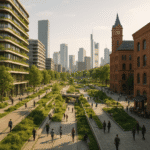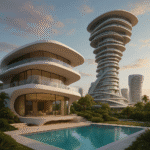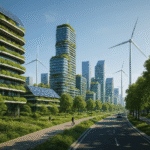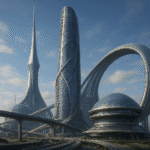As the global population continues to rise and urban areas become increasingly congested, the demand for affordable housing solutions has never been more pressing. Futuristic architecture, with its innovative use of technology and materials, offers promising high-tech solutions to address this critical issue. This article explores the intersection of cutting-edge architectural design and affordable housing, highlighting how these advancements can transform urban living.
Revolutionary Building Materials
One of the most significant advancements in futuristic architecture is the development of revolutionary building materials. These materials not only enhance the structural integrity and aesthetic appeal of buildings but also contribute to cost-effectiveness and sustainability. A prime example is the use of 3D-printed concrete, which has gained traction in recent years. This technology allows for the rapid construction of housing units at a fraction of the traditional cost, making it an ideal solution for affordable housing projects.
3D-printed concrete is not only cost-effective but also environmentally friendly. The process generates less waste compared to conventional construction methods, and the materials used can often be sourced locally, reducing transportation emissions. Additionally, the precision of 3D printing allows for intricate designs that maximize space efficiency, a crucial factor in urban environments where land is scarce and expensive.
Another innovative material making waves in the field of futuristic architecture is graphene. Known for its exceptional strength and conductivity, graphene is being explored as a potential component in building materials. Its incorporation into construction could lead to lighter, more durable structures that require less maintenance over time. This durability translates to long-term savings for residents and developers, further enhancing the affordability of housing projects.
Smart Home Technologies
Incorporating smart home technologies into affordable housing is another way futuristic architecture is addressing the needs of urban populations. These technologies not only improve the quality of life for residents but also contribute to energy efficiency and cost savings. Smart thermostats, for example, allow residents to optimize their energy usage, reducing utility bills and minimizing environmental impact.
Moreover, the integration of IoT (Internet of Things) devices in housing units can streamline maintenance and management processes. Sensors can detect issues such as water leaks or electrical faults, alerting maintenance teams before they escalate into costly repairs. This proactive approach to building management not only preserves the integrity of the housing units but also ensures a safe and comfortable living environment for residents.
Smart home technologies also offer enhanced security features, which are particularly valuable in affordable housing communities. From smart locks to surveillance systems, these technologies provide residents with peace of mind, knowing that their homes are protected. The ability to control these systems remotely via smartphones or other devices adds an extra layer of convenience and accessibility.
Modular and Prefabricated Housing
Modular and prefabricated housing solutions are gaining popularity as a means to provide affordable housing quickly and efficiently. These construction methods involve the assembly of pre-manufactured sections, or modules, which are then transported to the building site for final assembly. This approach significantly reduces construction time and labor costs, making it an attractive option for developers and municipalities seeking to address housing shortages.
Prefabricated housing also offers flexibility in design, allowing for customization to meet the specific needs of different communities. This adaptability is crucial in urban areas where space constraints and diverse populations require tailored housing solutions. Furthermore, the controlled environment of a manufacturing facility ensures consistent quality and reduces the likelihood of construction errors, leading to more reliable and durable housing units.
In addition to cost and time savings, modular and prefabricated housing can be more sustainable than traditional construction methods. The precision of factory production minimizes material waste, and the ability to incorporate energy-efficient features during the manufacturing process enhances the overall sustainability of the housing units. As cities strive to reduce their carbon footprints, these eco-friendly construction methods align with broader environmental goals.
Vertical Urban Farms and Green Spaces
Futuristic architecture is not only about the buildings themselves but also about integrating green spaces and sustainable practices into urban environments. Vertical urban farms and green roofs are becoming increasingly popular as a means to provide affordable housing residents with access to fresh produce and recreational areas. These green spaces contribute to the overall well-being of residents and promote a sense of community within housing developments.
Vertical farms utilize hydroponic or aeroponic systems to grow crops in vertically stacked layers, often within the confines of a building. This innovative approach to agriculture maximizes space efficiency and can be implemented in urban areas where traditional farming is not feasible. By providing residents with access to fresh, locally grown produce, vertical farms enhance food security and reduce the carbon footprint associated with transporting food from rural areas.
Green roofs, on the other hand, offer a range of environmental benefits, including improved air quality, reduced urban heat island effect, and enhanced stormwater management. These features not only contribute to a healthier urban environment but also provide residents with valuable outdoor spaces for relaxation and recreation. The integration of green roofs into affordable housing projects demonstrates a commitment to sustainability and quality of life for urban dwellers.
Community-Centric Design
At the heart of futuristic architecture for affordable housing is a focus on community-centric design. This approach prioritizes the needs and well-being of residents, fostering a sense of belonging and social cohesion. By incorporating communal spaces, such as shared gardens, playgrounds, and community centers, architects can create environments that encourage interaction and collaboration among residents.
Community-centric design also involves considering the cultural and social context of the area in which the housing is being developed. By engaging with local communities and stakeholders, architects can ensure that the design of affordable housing projects reflects the unique identity and needs of the residents. This participatory approach not only enhances the relevance and acceptance of the housing but also empowers residents to take an active role in shaping their living environment.
Furthermore, community-centric design can contribute to the economic vitality of urban areas by incorporating mixed-use developments that combine residential, commercial, and recreational spaces. This integration of functions creates vibrant neighborhoods that offer residents access to essential services and amenities, reducing the need for long commutes and enhancing the overall quality of life.
Conclusion
Futuristic architecture holds immense potential for addressing the global challenge of affordable housing. Through the innovative use of materials, smart technologies, and sustainable practices, architects and developers can create housing solutions that are not only cost-effective but also enhance the quality of life for urban residents. As cities continue to grow and evolve, embracing these high-tech solutions will be crucial in ensuring that everyone has access to safe, comfortable, and affordable housing.










